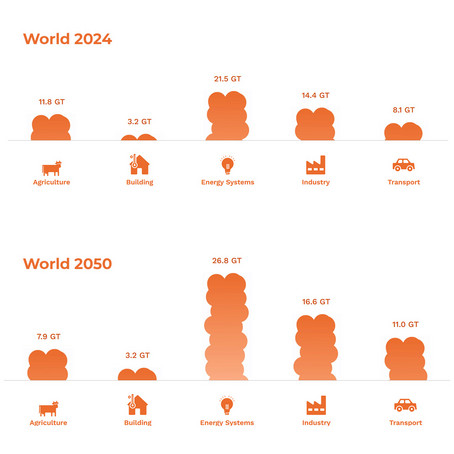New emissions model reveals problems with carbon forecasts
Researchers at WU (Vienna University of Economics and Business) have developed a new model for forecasting greenhouse gas emissions. It shows that the global climate targets can no longer be achieved unless drastic measures are taken – and it reveals that some countries vastly overstate their carbon reduction efforts.
In the Paris Climate Agreement, the countries of the world have committed themselves to limiting the global rise in temperature to 1.5 degrees Celsius, if possible. To achieve this, humanity must reduce its greenhouse gas emissions to zero by the middle of the 21st century. To monitor the progress, every two years countries are required to report how much carbon dioxide and other greenhouse gases they are currently emitting and what measures they are taking to get closer to the net-zero target.
So much for the theory – but in practice, the task of calculating emission levels is riddled with pitfalls. As Jesús Crespo Cuaresma, professor at WU’s Department of Economics, points out, “The types of institutions tasked with preparing these estimates vary from country ton country, and they also use different models. That’s why we thought it would be important to develop a comprehensive model for generating comparable sectoral emission projections that can be used to contrast the reported figures, among other things.”
Together with his co-researcher Lukas Vashold, Professor Crespo Cuaresma has developed such a model and presented it in the Communications Earth & Environment journal: Based on key economic and demographic data, it produces realistic projections for the greenhouse gas emissions of 173 countries up until the year 2050 – broken down into energy, industry, and transportation sector emissions. The result: “If we compare these projections with countries’ reported emissions targets, we find some discrepancies.”

Worldwide greenhouse gas emissions in 2050: According to the WU researchers' forecasts, the largest increase is expected in the energy sector. Only the agricultural sector is predicted to see a decrease.
Our current efforts are not enough
The WU economists based their calculations on a “middle of the road” scenario, where the economy continues to develop roughly the same way as before, without any radical technological or political changes. However, in the absence of any drastic changes, this model predicts a significant increase in global greenhouse gas emissions by 2050. “Current efforts are nowhere near enough to meet the 1.5 degree target. In fact, the so-called global carbon budget for this target would already be used up by 2030,” says Lukas Vashold.
In developing and emerging countries, emissions will continue to rise, driven by strong economic and population growth. Some industrialized countries, on the other hand, will be able to reduce their emissions – primarily in the industrial and energy sectors. In the transportation sector, however, carbon emissions will continue to go up, even in developed economies. “Greater electrification of the transportation sector is an important building block for achieving net zero,” explains Jesús Crespo Cuaresma. “But it’s crucial that the power we use to charge our electric cars must be produced in a more climate-neutral way than has been the case so far.”
Relatively little is expected to change until 2050 regarding the world’s top greenhouse gas emitters, unless we see a radical departure from previous trends: As is already the case today, China – and particularly China’s energy sector – will be by far the biggest producer of greenhouse gases. However, India will catch up significantly, especially in the energy and industry sectors, and is projected to overtake the USA as the second largest emitter in 2033.
Nevertheless, Lukas Vashold has little sympathy for the oft-repeated argument that any steps taken by a small country like Austria are useless because their effects are dwarfed by the emissions generated by big nations. “If Austria were to reduce its emissions to zero, this would of course only make a marginal difference globally. But we can be a role model when it comes to developing and implementing innovative approaches and getting other countries on board. This can generate effects that are significant from a global perspective,” Vashold points out.
![[Translate to English:] Treibhausgasemissionen 2024 und 2050 in Österreich](/fileadmin/wu/_processed_/8/5/csm_Grafik_GHG_Oesterreich_8478207c6f.jpg)
Greenhouse gas emissions in Austria in 2024 and 2050: Emissions will fall significantly in all sectors – with the exception of transportation, where a significant increase is expected. The effects of a more widespread use of electric cars have already been factored in.
Overstated reductions
Major discrepancies emerge when comparing the model data with the emissions figures reported by some countries at the UN climate conferences: Emerging countries usually produce their own emissions forecasts for a “business as usual” scenario and define their planned emission reduction targets in relation to their forecasts. When comparing these figures with the model put forth by the two WU economists, it becomes clear that some countries’ forecasts are greatly exaggerated. Some nations like Indonesia, Iran, or Turkey project emission levels that exceed the model’s figures by as much as 50 percent or even more. “These countries are probably overstating their emissions forecasts to make their planned reduction measures look more effective,” explains Jesús Crespo Cuaresma. “From an economic perspective, this is exactly what you would expect to see: There are incentives to go this route, so this is what countries do.”
According to Jesús Crespo Cuaresma, establishing a scientific watchdog organization would be one possible way of eliminating these economic incentives and stepping up efforts to achieve climate neutrality. “Our model could be part of these efforts. But our job ends here. Now it’s up to national decision-makers and supranational organizations to take these evidence-based results on board and use them to critically reexamine the processes that have been in place so far,” Crespo Cuaresma says.
To raise broader public awareness of these challenges, the researchers have collaborated with the World Data Lab to develop the “World Emissions Clock.” On the worldemissions.io website, all the relevant data can be compared by country and by sector, and they can be contrasted with other scenarios based on different assumptions.
Detailed study results and further information
Lukas Vashold, Jesús Crespo Cuaresma: A unified framework for projecting sectoral greenhouse gas emissions. Nature Communications Earth & Environment
https://doi.org/10.1038/s43247-024-01288-9
This study was carried out as part of the eXplore! initiative, which aims to leverage research findings to bring scientific theory and business practice closer together. This funding initiative was launched in 2021 by the B&C Private Foundation and Michael Tojner, in cooperation with WU Vienna.
